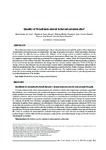Use este identificador para citar ou linkar para este item:
http://www.alice.cnptia.embrapa.br/alice/handle/doc/1049870Registro completo de metadados
| Campo DC | Valor | Idioma |
|---|---|---|
| dc.contributor.author | COSTA, D. A. da | pt_BR |
| dc.contributor.author | ALVARES, V. de S. | pt_BR |
| dc.contributor.author | NOGUEIRA, R. M. | pt_BR |
| dc.contributor.author | KUSDRA, J. F. | pt_BR |
| dc.contributor.author | MACIEL, V. T. | pt_BR |
| dc.contributor.author | MIQUELONI, D. P. | pt_BR |
| dc.date.accessioned | 2016-07-28T11:11:11Z | pt_BR |
| dc.date.available | 2016-07-28T11:11:11Z | pt_BR |
| dc.date.created | 2016-07-28 | pt_BR |
| dc.date.issued | 2016 | pt_BR |
| dc.identifier.citation | Revista Ceres, Viçosa, MG, v. 63, n. 3, p. 305-314, maio/jun. 2016. | pt_BR |
| dc.identifier.issn | 2177-3491 | pt_BR |
| dc.identifier.uri | http://www.alice.cnptia.embrapa.br/alice/handle/doc/1049870 | pt_BR |
| dc.description | The traditional system of collection and storage of Brazil nut compromises seriously the quality of these almonds as it contributes to the high incidence of contaminants, like fungi of the genus Aspergillus, which can produce aflatoxins. In this study, the objective was to evaluate the influence of the storage period in studied conditions, on the physicochemical characteristics and on the microbiological contamination of Brazil nuts. The experimental was designed as completely randomized, considering as treatments the storage period (0 - control, 30, 60, 90, 120 and 150 days) with four replicates of 3 kg of Brazil nuts each. The samples were submitted to physicochemical and microbiological analysis. It was observed that almonds submitted to the storage had their moisture content reduced by 78.2% at 150 days of storage, however, this reduction was not fast enough to avoid surface contamination by filamentous and potentially aflatoxins producing fungi. The critical period of contamination occurred on the first 30 days of storage when there was an increase of the studied fungi, as well as B1 and total aflatoxin. The studied storage conditions were four times more effective in reducing the product moisture content than the traditional methods, however, pre-drying is necessary to avoid contamination of the product. | pt_BR |
| dc.language.iso | eng | eng |
| dc.rights | openAccess | eng |
| dc.subject | Castanha do brasil | pt_BR |
| dc.subject | Aeration silos | pt_BR |
| dc.subject | Aflatoxinas | pt_BR |
| dc.subject | Nuez del Brasil | pt_BR |
| dc.subject | Calidad de almacenaje | pt_BR |
| dc.subject | Calidad de la fruta | pt_BR |
| dc.subject | Enfermedades postcosecha | pt_BR |
| dc.title | Quality of Brazil nuts stored in forced aeration silos. | pt_BR |
| dc.type | Artigo de periódico | pt_BR |
| dc.date.updated | 2017-06-12T11:11:11Z | pt_BR |
| dc.subject.thesagro | Castanha do pará | pt_BR |
| dc.subject.thesagro | Bertholletia excelsa | pt_BR |
| dc.subject.thesagro | Fruto | pt_BR |
| dc.subject.thesagro | Qualidade | pt_BR |
| dc.subject.thesagro | Armazenamento | pt_BR |
| dc.subject.thesagro | Silo aéreo | pt_BR |
| dc.subject.thesagro | Doença de planta | pt_BR |
| dc.subject.thesagro | Fungo | pt_BR |
| dc.subject.thesagro | Contaminação fúngica | pt_BR |
| dc.subject.thesagro | Aflatoxina | pt_BR |
| dc.subject.nalthesaurus | Brazil nuts | pt_BR |
| dc.subject.nalthesaurus | Fruit quality | pt_BR |
| dc.subject.nalthesaurus | Storage quality | pt_BR |
| dc.subject.nalthesaurus | Silos | pt_BR |
| dc.subject.nalthesaurus | Postharvest diseases | pt_BR |
| dc.subject.nalthesaurus | Fungi | pt_BR |
| dc.subject.nalthesaurus | Aflatoxins | pt_BR |
| dc.subject.nalthesaurus | Aspergillus | pt_BR |
| riaa.ainfo.id | 1049870 | pt_BR |
| riaa.ainfo.lastupdate | 2017-06-12 | pt_BR |
| dc.identifier.doi | 10.1590/0034-737X201663030005 | pt_BR |
| dc.contributor.institution | DAVID AQUINO DA COSTA, UNIVERSIDADE FEDERAL DO ACRE | pt_BR |
| dc.contributor.institution | VIRGINIA DE SOUZA ALVARES, CPAF-ACRE | eng |
| dc.contributor.institution | ROBERTA MARTINS NOGUEIRA, UNIVERSIDADE FEDERAL DO MATO GROSSO | eng |
| dc.contributor.institution | JORGE FERREIRA KUSDRA, UNIVERSIDADE FEDERAL DO ACRE | eng |
| dc.contributor.institution | VLAYRTON TOME MACIEL, CPAF-ACRE | eng |
| dc.contributor.institution | DANIELA POPIM MIQUELONI, UNIVERSIDADE FEDERAL DO ACRE. | eng |
| Aparece nas coleções: | Artigo em periódico indexado (CPAF-AC)  | |
Arquivos associados a este item:
| Arquivo | Descrição | Tamanho | Formato | |
|---|---|---|---|---|
| 26097.pdf | 472,94 kB | Adobe PDF |  Visualizar/Abrir |









